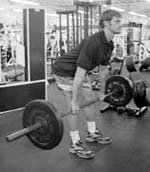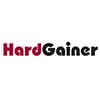The deadlift is the King of lifts—it's the bad boy on the block, it takes no prisoners. If you don't respect it, and don't do it with good form and on an irregular basis, you'll get hurt. Few men approach this lift, exercise or movement (whatever you prefer to call it) with the proper attitude. I hear from all kinds of authorities that it's a useless movement, and a waste of time for a bodybuilder. They are wrong.
Every man who uses a barbell should deadlift if he has a healthy back, and he should do it with a flat back to keep a healthy back. Something that opened my eyes to the deadlift was, over the years, taking my powerlifting team to prisons. The Pit has lifted at the Kentucky State Prison, Eddyville and the Marion Federal Penitentiary.
Lifting in a prison against men whose struggles in life are different to mine and yours, and causes them to have respect for what's hard and not so much for that which requires skill. And in prison I saw some very good deadlifters. No disrespect for the wide-stance deadlift, but I didn't see many wide-stance deadlifters in prison. What I saw were close-foot pulls through a long distance of travel, done by men with a great respect for strength.
I've seen a close-stance deadlift of 760 pounds done by a man standing about 6' 1" tall, and he weighed only about 180 pounds. With a close stance is the way you want to deadlift if you want the most from the movement.
I want to say that it's my belief that the deadlift builds more usable strength than any other movement, and affects more muscle than any other movement. The deadlift is also the easiest movement to overtrain. It needs to be treated with great care.
Deadlift Stance
To keep the back flat and tight is of utmost importance. As you start your pull, never let your back start to round, but keep it tight and flat. Here's how to deadlift by the numbers:
- As you step to the bar, place your feet no more than shoulder-width apart, and toes pointed out so that as you bend over and grip the bar with bent legs, flat back and head up, the feel is right. Fine-tune the stance and toe flare until you feel right in the bottom position.
- The pull should start over your feet, and you pull the bar towards you as you pull the bar up. You must keep a flat back and begin your pull with good control. Do not jerk on the bar. In most cases the bar will be right against the legs just after you start the pull.
- As you start the pull, your shoulders and hips must move at the same time! This is very important, and you may need a spotter/assistant to tell you if your hips are moving up and your legs are beginning to straighten and yet the bar has hardly moved from the floor. The typical error is that lifters raise their hips faster than their shoulders, and straighten their legs too quickly. This error distorts the exercise and puts massive stress on the lower back, leads to rounding of the back, and injury.
- By the time the bar gets to the knees the legs should still be bent, and the bar should be right against the legs. As you get close to the finish, push your hips forward and stand erect.
- Don't lean back, but stand erect with legs straight and shoulders pulled back. Deadlift correctly and save your back. The deadlift is a great lift—the only true power lift, since the use of support gear has ruined the squat and bench press. Never deadlift intensively more than twice a month, and never more than one work set per workout. If you've been training hard on the deadlift for six months or better, drop the frequency to every third week.
Example Deadlift Routine

Here's a good deadlift routine. It's not the only way to do it, but it's as good as any and better than most. Only work sets are listed - warm-up work is additional, and necessary - and exercises unrelated to the deadlift haven't been included here. You must, however, keep your overall training program brief if it's to be effective.
- Deadlift: 15 reps
- Back Extension: 6 reps
- Negative Chin-ups: 10 reps
- Side Bends: 15 reps
The back extension, negative chin, and side bend should be done very slowly-10 seconds up and 10 seconds down.
Other Issues: The Bench Press
Recently a man asked me if I thought an abbreviated training program would be effective for him. The man weighed about 225 pounds at 6-1 tall. He explained that his best bench press was 315 but after going on a very abbreviated routine in which he only did two sets of bench presses a week, his bench press went down to 300. As I understood, he was doing a general routine with little assistance work and just a few basic movements. I don't know how hard he was training though.
Perhaps he wasn't training as hard as he needed to for good results. But to know, I'd have needed to see him train. If this man is as heavy in bodyweight as he wants to be, and his main interest is the bench press, he needs to add assistance work for the bench press, improve his technique, train hard and drop back in his other work in order to have the recovery ability to cope with the added assistance work. He would probably have to trade some strength elsewhere in order to boost his bench press.
If, however, you're a true hard gainer and want to build bigger muscles, you have to think in terms of gaining on your whole routine, not just your bench press. If you're a powerlifter you must improve your total, not just one movement like the bench press. That's the way a hard gainer needs to think. I've known men who could deadlift over 550 yet who couldn't bench press 300.
David Wedding, one of The Pit's powerlifters, has been able to become very good at the deadlift and squat, with 560 and 480 respectively, but his bench press is sub par at 250, all at 165 pounds bodyweight. If David decided to drop the squat and deadlift he could improve his bench press by 20-50 pounds, but in the end he would lose strength overall. Strength is a whole lot more than, "How good is your bench press?"
Of the three great pressing movements, the bench press is third behind the dip and overhead press. Don't worry about one particular movement. Give each compound movement in your routine your best, which means in some cases no more than one work set per exercise, in other cases two or maybe three work sets.
Almost none of you can productively train over twice a week, and most can productively do no more than five work sets in a single workout. Some extreme hard gainers can productively do no more than three work sets a week. You must find out for yourself. If you're not gaining, but you are training hard and eating and sleeping well, in most cases you need to train less.
I believe the following are the best basic free-weight movements: deadlift, squat, chin (supinated-grip), press, dip, row (with a dumbbell), shrug and bench press. Beyond this are the best assistance movements: side bend, crunch sit-up, back extension and L-fly-these help protect the back and shoulders. The order these exercises are written in, in my opinion, is the order of their importance in building strength.
As for machines, the best are the leg press, old Nautilus plate-loaded pullover, and the pull-down. The leg press must be a good machine-Hammer Strength's, for its price, is hard to beat. The old Nautilus plate-loaded pullover is impossible to duplicate with a barbell, but it must be done correctly-very slowly-and then you have a great upper-back workout.
The pull-down is needed by hard gainers, so it's important. I don't know of anything else that can do anything that these exercises can't. And consider that The Pit has vintage Nautilus machines-1970 models. We also have some of the new machines. And I'm in the process of upgrading our barrel, bag, and log equipment.
We use all types of equipment, and know well what works if you work. But the basics will always be the same, and they will always be the best. No equipment, however, is going to replace your heart and mind in getting you the strength you want.
Especially for new readers...
While strength and physical development are our shared interests, some of you are primarily concerned with your physical appearance (with strength building being just a means to an end), others of you are primarily interested in strength and strength feats, while a third group is interested in a combination of appearance and performance.
And some of you have physical limitations that proscribe methods of training that other people gain well on. To cater for these different needs and preferences, HARDGAINER provides a diversity of training information-but always within the framework of abbreviated training routines. Be prudent in what you select, only put into practice what's appropriate for you to apply, and always keep safety uppermost in your mind.
There are many ways to train, each proven to be effective, but not necessarily effective and safe for all trainees. All our contributors have their own emphases and preferences, coming from their own experiences, but all recognize that no single person "knows it all." The opinions published in HARDGAINER are those of individual authors, and not necessarily those of the publisher and CS Publishing Ltd.
The training methods promoted in HARDGAINER are physically very demanding. If you have any doubts about your body's ability to tolerate any selfimposed exercise program, consult with your physician. Proceed with caution.
Copyright 2000 by CS Publishing
